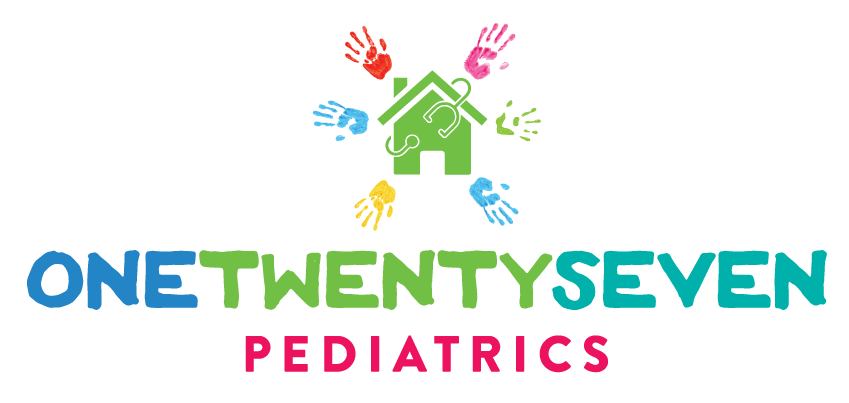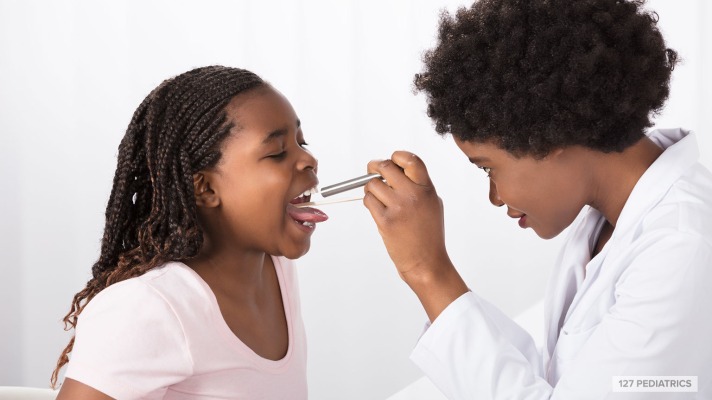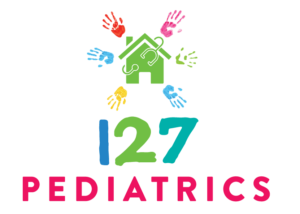What in the world is Herpangina?
Let’s start with what it is not. Herpangina is not the same as strep throat, but they have many overlapping symptoms. Parents ask me this question pretty often, and I can understand where their confusion comes from.
In this article, we will look at each disease, how they are similar, and how they are different. By the end, you will understand how to manage your child’s symptoms of both illnesses and which one requires antibiotics to treat.
Herpangina
The name of this condition almost always gives parents pause. It sounds like it is something pretty awful, but really it is a common childhood viral illness. Herpangina and hand, foot, and mouth disease are similar. Both illnesses are caused by the same virus but just manifest their symptoms differently.
Herpangina causes a terrible sore throat while hand, foot, and mouth disease causes a sore throat plus blisters on other parts of the body. You guessed it, the virus causes blisters on the palms and soles (and often the diaper area, back, belly, and face…)
Both illnesses are caused by viruses in the Enterovirus family. Common viruses such as Coxsackie, Enterovirus, and Echovirus cause these miserable illnesses. A single person can also have this illness several times due to all of the different types of viruses and different strains of these viruses that cause this illness.
Strep Throat
Strep throat is the common name for a sore throat infection that is caused by Group A Streptococcus. This germ is a bacteria and therefore strep throat is a bacterial infection.
In children over the age of 3 years old, pediatricians treat strep throat with antibiotics. Treatment is indicated in order to prevent the very rare side effects of strep infection that can cause kidney and heart problems. Although Rheumatic Fever is rare, it is the main reason why we treat strep throat. Otherwise, our immune systems would easily fight off this bacterial infection.
Children under 3 years old are not susceptible to Rheumatic fever and therefore, pediatricians do not routinely test these kids for strep throat. The exception comes if the child is having severe symptoms of strep throat.
What are the similarities and differences?
Both strep and herpangina can start out with similar symptoms. Common symptoms include sore throat, fever, abdominal pain, loss of appetite, and sometimes headaches.
Strep throat requires a throat swab to diagnose while herpangina can be diagnosed most often by physical exam.
On physical examination, strep throat often causes redness of the back of the throat and tonsils. Additionally, the examiner might note petechiae (or small broken blood vessels) along the surface of the hard or soft palate. Most often, kids with strep throat do not have viral upper respiratory symptoms such as runny nose and cough. They will most often have a sudden fever with or without a sore throat, headache, and/or abdominal pain.
On the other hand, the exam findings of herpangina include small blister-like bumps or ulcers in the back of the throat and soft palate in addition to redness. Along with mouth sores, kids will also often have a fever and abdominal pain.
Throat pain due to blisters is the main difference between herpangina and strep throat.
When to See Your Child’s Pediatrician
Children with a sudden onset of fever accompanied by sore throat should be seen by their pediatrician within a few days of the onset of their symptoms. This is especially true in the absence of other viral symptoms or after known exposure to other kids with strep throat infections.
If you look in your child’s mouth and see blisters, you can observe your child and treat their symptoms at home for a few days before alerting their pediatrician. The most important treatment for this viral infection is to keep your child hydrated. You can stay on top of their Motrin or Tylenol dosing, use numbing throat lozenges (in older kids), and give them popsicles or ice cream to help their throat pain.
Eating a bland diet and not giving spicy foods will also help your child to eat and drink better.
If your child is not able to drink often enough to urinate every few hours, you should alert your pediatrician and/or take them to urgent care.
Often Asked Questions
In addition to the things that we covered, many parents have specific questions about the contagiousness of these illnesses. They want to know how to treat the illness and prevent their child from sickness.
How contagious are herpangina and strep throat?
Spread of herpangina, as well as hand, foot, and mouth disease, occur like wildfire through childcare and school settings. This illness is most contagious within the first 7 days of symptoms, but can also spread through fecal matter for several weeks after the initial illness. It is so common, that we don’t always isolate a child who has blisters on their hands and feet as long as they are feeling well and don’t have a fever.
Here are CDC’s guidelines for returning to school.
Strep throat often requires closer contact with an infected person unlike viral illnesses like herpangina that spread quickly with less direct contact. Both can spread by droplets and by touching contaminated surfaces and then touching your eyes or mouth.
Only about 25% of household contacts will contract strep from an infected family member while herpangina is extremely contagious.
How does the treatment of herpangina differ from strep throat?
- Strep throat is caused by a bacterial infection and requires antibiotics to treat.
- Herpangina is caused by a virus and requires time and symptomatic treatment.
- Medicine for fever can help a child to feel better from both illnesses.
Can I prevent my child from getting either of these illnesses?
The best way to prevent your child from getting any illness is to avoid being around people who are ill, cover sneezes and coughs, and frequent hand washing.
A vast majority of kids will experience one or both of these illnesses at some point in their childhood.
If you are looking for a pediatrician that is on call for your family and sees sick kids quickly look no further than 127 Pediatrics. Dr. Wadley is accepting a limited number of new patients.
© 127 Pediatrics; July 2023
This article exists for informational purposes only and should not be construed as medical advice.

Dr. Andrea Wadley is the owner, pediatrician, and breastfeeding medicine specialist for 127 Pediatrics. She has an established house-calls-only concierge pediatric practice in Colleyville, TX. She is also the owner and operator of the 127 Pediatrics Online Breastfeeding Medicine and Education Center.


